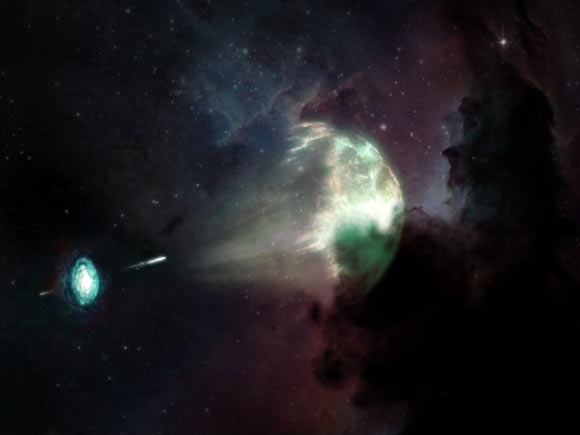Astronomers using the Atacama Large Millimeter/submillimeter Array (ALMA) have for the first time detected the millimeter afterglow of a short-duration gamma-ray burst, a fiery explosion caused by the merger of a neutron star with another star.

This artist’s conception shows the merger between a neutron star and another star (seen as a disk, lower left) which caused an explosion resulting in SGRB 211106A (white jet, middle), and left behind what astronomers now know to be one of the most luminous afterglows on record (semi-spherical shock wave mid-right); while dust in the host galaxy obscured most of the visible light (shown as colors), millimeter light from the event (depicted in green) was able to escape and reach ALMA. Image credit: ALMA / ESO / NAOJ / NRAO / M. Weiss, NRAO, AUI & NSF.
Short-duration gamma-ray bursts (sGRBs) are produced in the catastrophic merger of binary systems involving a neutron star.
These explosive events are a known site of r-process nucleosynthesis and thus a source of heavy elements, such as platinum and gold.
“These mergers occur because of gravitational wave radiation that removes energy from the orbit of the binary stars, causing the stars to spiral in toward each other,” said Dr. Tanmoy Laskar, an astronomer in the Department of Astrophysics/IMAPP at Radboud University and the Department of Physics & Astronomy at the University of Utah.
“The resulting explosion is accompanied by jets moving at close to the speed of light.”
“When one of these jets is pointed at Earth, we observe a short pulse of gamma-ray radiation or an sGRB.”
An sGRB event usually lasts only a few tenths of a second. Astronomers then look for an afterglow, an emission of light caused by the interaction of the jets with surrounding gas.
Even still, they’re difficult to detect; only half-a-dozen sGRBs have been detected at radio wavelengths, and until now none had been detected in millimeter wavelengths.
“sGRB afterglows are very luminous and energetic,” Dr. Laskar said.
“But these explosions take place in distant galaxies which means the light from them can be quite faint for our telescopes on Earth.”
“Before ALMA, millimeter telescopes were not sensitive enough to detect these afterglows.”
At roughly 20 billion light-years from Earth, an sGRB event designated SGRB 211106A is no exception.
The light from this sGRB was so faint that while early X-ray observations with NASA’s Neil Gehrels Swift Observatory saw the explosion, the host galaxy was undetectable at that wavelength, and scientists weren’t able to determine exactly where the explosion was coming from.
“Afterglow light is essential for figuring out which galaxy a burst comes from and for learning more about the burst itself,” Dr. Laskar said.
“Initially, when only the X-ray counterpart had been discovered, astronomers thought that SGRB 211106A might be coming from a nearby galaxy.”
“A significant amount of dust in the area also obscured the object from detection in optical observations with the NASA/ESA Hubble Space Telescope.”
Each wavelength added a new dimension to scientists’ understanding of SGRB 211106A, and millimeter, in particular, was critical to uncovering the truth about the burst.
“Hubble observations revealed an unchanging field of galaxies,” Dr. Laskar said.
“ALMA’s unparalleled sensitivity allowed us to pinpoint the location of the sGRB in that field with more precision, and it turned out to be in another faint galaxy, which is further away.”
“That, in turn, means that this short-duration gamma-ray burst is even more powerful than we first thought, making it one of the most luminous and energetic on record.”
The team’s results will be published in the Astrophysical Journal Letters.
_____
Tanmoy Laskar et al. 2022. The First Short GRB Millimeter Afterglow: The Wide-Angled Jet of the Extremely Energetic SGRB 211106A. ApJL, in press; arXiv: 2205.03419







